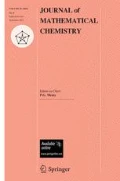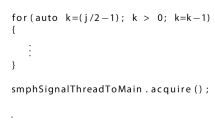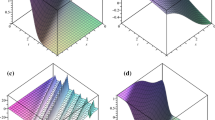Abstract
Probabilistic evolution theory (PREVTH) is used for the solution of initial value problems of first order explicit autonomous ordinary differential equation sets with second degree multinomial right hand side functions. It is an approximation method based on Kronecker power series: a rewriting of multivariate Taylor series using matrices having certain flexible parameters. Kronecker power series have matrices which are called telescope matrices: \(n \times n^{j+1}\) matrices where j is the index of summation. The additive terms of each telescope matrix is formed through Kronecker product from both sides by Kronecker powers of identity matrices. Recently, squarification is proposed in order to avoid the growing of the matrices in size at each additive term of the series. This paper explains the squarification procedure: the procedure used in order to avoid Kronecker multiplications within PREVTH so that the sizes of the matrices do not grow and so that the amount of necessary computation is reduced. The recursion between squarified matrices is also given. As a numerical application, the solution of a Hénon–Heiles system is provided.

Similar content being viewed by others
References
M. Demiralp, H. Rabitz, Int. J. Eng. Sci. 31(2), 307 (1993). doi:10.1016/0020-7225(93)90043-T
M. Demiralp, H. Rabitz, Int. J. Eng. Sci. 31(2), 333 (1993). doi:10.1016/0020-7225(93)90044-U
E. Demiralp, M. Demiralp, L. Hernandez-Garcia, J. Math. Chem. 50, 870 (2012). doi:10.1007/s10910-011-9930-4
M. Demiralp, E. Demiralp, L. Hernandez-Garcia, J. Math. Chem. 50, 850 (2012). doi:10.1007/s10910-011-9929-x
M. Demiralp, J. Math. Chem. 51(4), 1170 (2012). doi:10.1007/s10910-012-0079-6
M. Demiralp, N. Baykara, J. Math. Chem. 51(4), 1187 (2012). doi:10.1007/s10910-012-0080-0
M. Demiralp, B. Tunga, J. Math. Chem. 51(4), 1198 (2012). doi:10.1007/s10910-012-0081-z
M. Demiralp, E. Demiralp, J. Math. Chem. 51(1), 58 (2012). doi:10.1007/s10910-012-0070-2
M. Demiralp, E. Demiralp, J. Math. Chem. 51(1), 38 (2012). doi:10.1007/s10910-012-0064-0
C. Gözükırmızı, M. Demiralp, J. Math. Chem. 52(3), 866 (2014). doi:10.1007/s10910-013-0298-5
C. Gözükırmızı, M. Demiralp, J. Math. Chem. 52(3), 881 (2014). doi:10.1007/s10910-013-0299-4
F. Hunutlu, N. Baykara, M. Demiralp, Int. J. Comput. Math. 90(11), 2326 (2013)
E. Tataroğlu, M. Demiralp, Int. J. Math. Comput. Methods 1, 201 (2016)
M.E. Kırkın, M. Demiralp, Int. J. Comput. 1, 158 (2016)
M. Ayvaz, M. Demiralp, J. Math. Chem. 52(8), 2161 (2014). doi:10.1007/s10910-014-0371-8
M. Ayvaz, M. Demiralp, J. Math. Chem. 52(8), 2294 (2014). doi:10.1007/s10910-014-0381-6
M. Demiralp, in Proceedings of the 19th International Conference on Applied Mathematics (AMATH’14) (WSEAS Press, İstanbul, 2014), ISBN:978-1-61804-258-3, pp. 99–104
M.E. Kırkın, C. Gözükırmızı, in AIP Conference Proceedings, vol. 1702 (2015). doi:10.1063/1.4938947
C. Gözükırmızı, M. Demiralp, in AIP Conference Proceedings, vol. 1702 (2015). doi:10.1063/1.4938937
The OEIS Foundation Inc. The Online Encyclopedia of Integer Sequences (2012). http://oeis.org
C. Gözükırmızı. Sequence A262180 in [20] (2015)
J.C. Butcher, Numerical Methods for Ordinary Differential Equations (Wiley Online Library, Hoboken, 2008)
H.Z. Munthe-Kaas, A. Lundervold, Found. Comput. Math. 13(4), 583 (2013). doi:10.1007/s10208-013-9167-7
R.I. McLachlan, K. Modin, H. Munthe-Kaas, O. Verdier, What are Butcher series, really? The story of rooted trees and numerical methods for evolution equations (2016). arXiv:1512.00906
A. Iserles, H.Z. Munthe-Kaas, S.P. Nørsett, A. Zanna, Acta Numer. 2000(9), 215 (2000)
A. Iserles, G. Quispel, Why Geometric Numerical Integration? (2016). arXiv:1602.07755
K. Ebrahimi-Fard, D. Manchon, Found. Comput. Math. 14(1), 1 (2014). doi:10.1007/s10208-013-9172-x
Acknowledgments
First author would like to thank Richard J. Fateman for an e-mail communication on arbitrary precision arithmetic and exact arithmetic.
Author information
Authors and Affiliations
Corresponding author
Rights and permissions
About this article
Cite this article
Gözükırmızı, C., Kırkın, M.E. & Demiralp, M. Probabilistic evolution theory for the solution of explicit autonomous ordinary differential equations: squarified telescope matrices. J Math Chem 55, 175–194 (2017). https://doi.org/10.1007/s10910-016-0678-8
Received:
Accepted:
Published:
Issue Date:
DOI: https://doi.org/10.1007/s10910-016-0678-8




